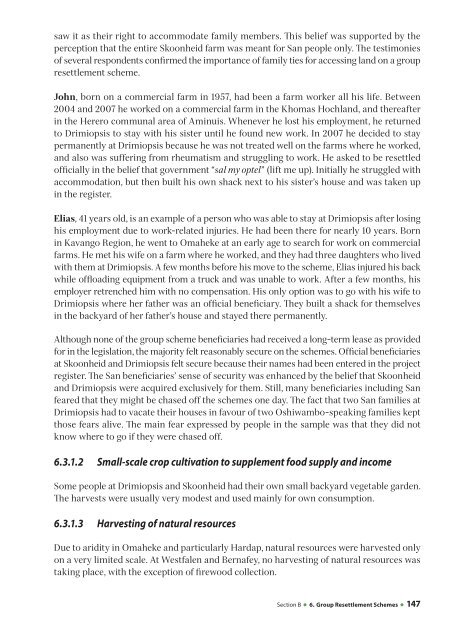Namibia country report
Namibia country report
Namibia country report
- No tags were found...
Create successful ePaper yourself
Turn your PDF publications into a flip-book with our unique Google optimized e-Paper software.
saw it as their right to accommodate family members. This belief was supported by theperception that the entire Skoonheid farm was meant for San people only. The testimoniesof several respondents confirmed the importance of family ties for accessing land on a groupresettlement scheme.John, born on a commercial farm in 1957, had been a farm worker all his life. Between2004 and 2007 he worked on a commercial farm in the Khomas Hochland, and thereafterin the Herero communal area of Aminuis. Whenever he lost his employment, he returnedto Drimiopsis to stay with his sister until he found new work. In 2007 he decided to staypermanently at Drimiopsis because he was not treated well on the farms where he worked,and also was suffering from rheumatism and struggling to work. He asked to be resettledofficially in the belief that government “sal my optel” (lift me up). Initially he struggled withaccommodation, but then built his own shack next to his sister’s house and was taken upin the register.Elias, 41 years old, is an example of a person who was able to stay at Drimiopsis after losinghis employment due to work-related injuries. He had been there for nearly 10 years. Bornin Kavango Region, he went to Omaheke at an early age to search for work on commercialfarms. He met his wife on a farm where he worked, and they had three daughters who livedwith them at Drimiopsis. A few months before his move to the scheme, Elias injured his backwhile offloading equipment from a truck and was unable to work. After a few months, hisemployer retrenched him with no compensation. His only option was to go with his wife toDrimiopsis where her father was an official beneficiary. They built a shack for themselvesin the backyard of her father’s house and stayed there permanently.Although none of the group scheme beneficiaries had received a long-term lease as providedfor in the legislation, the majority felt reasonably secure on the schemes. Official beneficiariesat Skoonheid and Drimiopsis felt secure because their names had been entered in the projectregister. The San beneficiaries’ sense of security was enhanced by the belief that Skoonheidand Drimiopsis were acquired exclusively for them. Still, many beneficiaries including Sanfeared that they might be chased off the schemes one day. The fact that two San families atDrimiopsis had to vacate their houses in favour of two Oshiwambo-speaking families keptthose fears alive. The main fear expressed by people in the sample was that they did notknow where to go if they were chased off.6.3.1.2 Small-scale crop cultivation to supplement food supply and incomeSome people at Drimiopsis and Skoonheid had their own small backyard vegetable garden.The harvests were usually very modest and used mainly for own consumption.6.3.1.3 Harvesting of natural resourcesDue to aridity in Omaheke and particularly Hardap, natural resources were harvested onlyon a very limited scale. At Westfalen and Bernafey, no harvesting of natural resources wastaking place, with the exception of firewood collection.Livelihoods after Section Land Reform: B ● 6. Group <strong>Namibia</strong> Resettlement <strong>country</strong> <strong>report</strong> Schemes (2010) ● 147
















